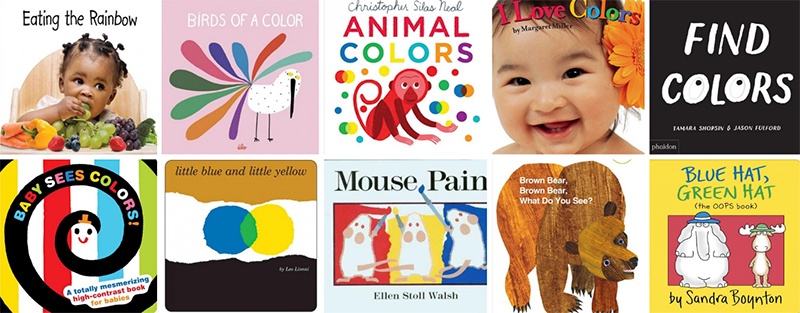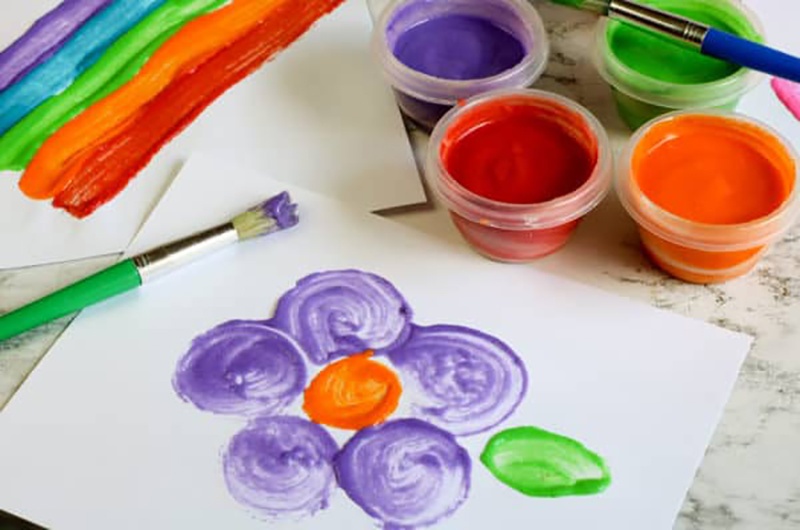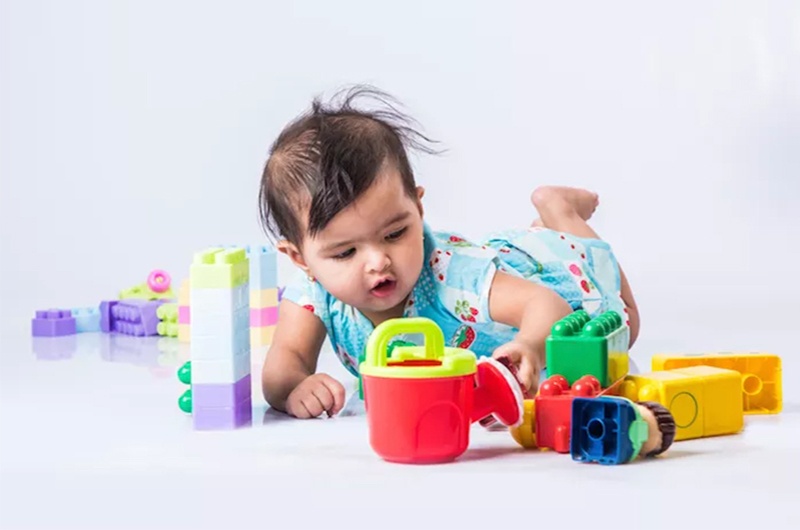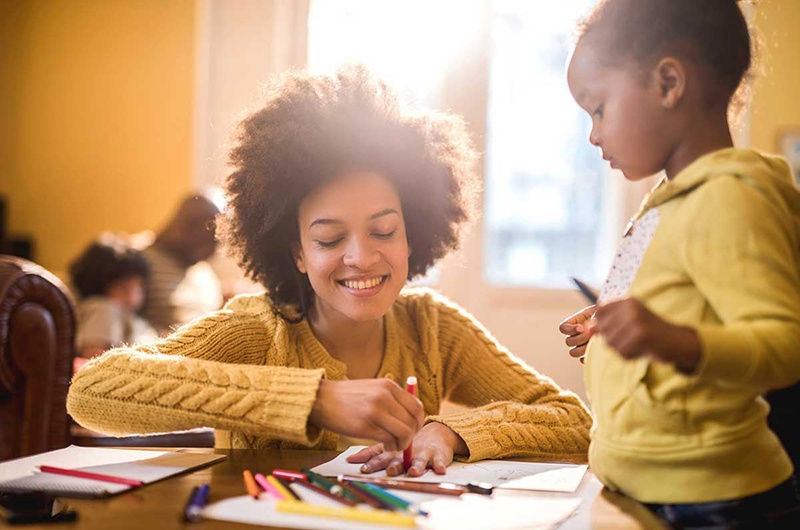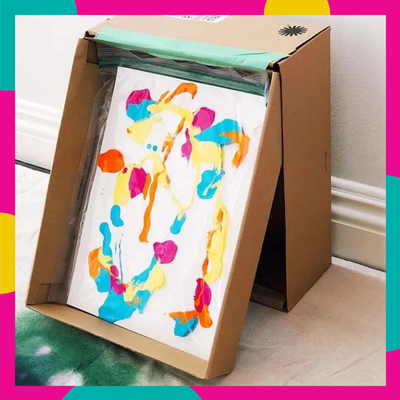Read, Baby, Read is a Free Library initiative focused on encouraging early literacy development among infants and young toddlers under two years old. We work with 12 participating libraries across Philadelphia to reach caregivers of all ages, providing resources that support early literacy skills, language development, and purposeful play. In addition, you can find early literacy tips and resources on our Instagram page @read.baby.read!
Each month, we bring you fun activity ideas with a theme based on the five early literacy practices from Every Child Ready To Read: Read, Sing, Write, Play, and Talk! So far, we’ve explored vehicles, animals, the body, water, food, shapes, feelings, and nature!
This month is all about color!
READ
There are many fantastic board books about color available in the Free Library’s catalog. It’s easy to place holds online for free and schedule curbside pick-up at neighborhood libraries.
- Eating The Rainbow by Rena Grossman
Turn mealtime into a colorful experience with this book full of fruits and vegetables. Also available in French and Arabic.
- Birds of a Color by Élo
This interactive book allows children to lift-the-flap to reveal a different color underneath the wings of each bird.
- Animal Colors by Christopher Silas Neal
What do you get when you combine two different colors and two different animals? A new color and a silly new word!
- I Love Colors by Margaret Miller
This book combines colors with another thing that babies love—looking at other babies’ faces!
- Find Colors by Tamara Shopsin and Jason Fulford
This experimental book has die-cut silhouettes that encourage children to find different colors in the room around them.
- Baby Sees Colors! by Akio Kashiwara
This high-contrast book is perfect for newborns, who are still developing vision skills.
- Little Blue and Little Yellow by Leo Lionni
This story follows two best friends who create the color green when they hug. You can even "extend" the story with a color mixing activity using playdough or gel baggies!
- Mouse Paint by Ellen Stoll Walsh
Explore primary and secondary colors in this tale of three clever mice. Also available in Spanish. Try adding a no-mess paint mixing activity when reading this story!
- Brown Bear, Brown Bear, What Do You See? by Bill Martin Jr. and Eric Carle
This classic book combines rhythmic text with colorful animals. Also available in Spanish, Arabic, Chinese, Tamil, and Hindi. (Watch Sarah read it during storytime.)
- Blue Hat, Green Hat by Sandra Boynton
This silly book will have you going "oh no!" as a turkey struggles to get dressed in colorful clothes! (Watch Sarah read it during storytime.)
Other recommendations include Colors by Jane Foster, Colors by John J. Reiss, Black Bird, Yellow Sun by Steve Light, Baby’s Colors by Karen Katz, Blue Bus, Red Balloon by Brian Biggs, Colors with Little Fish by Lucy Cousins, Spot The Animals: A Lift-The-Flap Book of Colors by Steve Jenkins, Steam Train, Dream Train: Colors by Sherri Duskey Rinker, My Very First Book of Colors by Eric Carle, Elmer’s Colours by David McKee, and Freight Train by Donald Crews.
SING
We love singing songs about color in our virtual storytimes! On our Instagram, you can see and hear Natasha sing "Five Green and Speckled Frogs" using a felt board, or watch Sarah sing "These Are Colors Over You" with scarves and "Color Soup" with a felt board (and a rainbow surprise!). For more color-themed storytime songs, including a variety of lap bounce and finger play rhymes, check out Jbrary’s Colors Playlist on YouTube. There are also many great "color songs" based on using the tune of a familiar children’s song but singing about color instead. Simply changing a word of a well-known song can make it about color too. Try changing "Twinkle Twinkle Little Star" to "Twinkle Twinkle Yellow Star" for a splash of color. Using props, such as scarves, is another great way to incorporate color into the song experience, even if the lyrics aren’t about color. Or you can make your own colorful song props using popsicle sticks and paper!
WRITE
The best way to "write" with color is by using colorful paint! There are lots of recipes for making your own paint at home, including flour paint, puffy paint, watercolor paint, edible paint, chalk paint, and bath paint! Letting your child mix different colored paint together is a great way for them to explore how primary colors like blue, yellow, and red combine to make secondary colors like purple, green, and orange. Want to explore color without the mess? There are many mess-free alternatives to traditional painting. Try using bubble wrap, plastic wrap, or a Ziploc bag to let your baby "paint" without even touching the paint. Another option is to put marbles in a box or beans in a jar and let your child shake it up with some paint—they’ll be creating a colorful masterpiece while also developing their motor skills!
PLAY
Making colorful DIY toys is an easy way to incorporate color into playtime. Colorful blocks are a great option—try painting some wooden blocks (or even Jenga pieces!) or create your own color viewer blocks. Color sorters are also perfect for learning about colors. Research shows that children can sort colors before they even learn the names of the actual colors. There are so many options for color sorting activities depending on what you have at your disposal. Try using Velcro, paper (or even a paper "train"!), felt, egg cartons, toilet paper rolls, cups, contact paper, playdough, or baskets. Sorting colors helps your child learn pattern recognition as well, which is an important math skill.
There are also a variety of ways to incorporate color into sensory play. Use food dye to make colorful spaghetti or rainbow rice, and then pour it in a sensory bin for an edible sensory experience. Colorful ice or dyed water is another great option for a sensory bin, as is this color mixing activity using soap foam! Don’t have a container you can use as a sensory bin? You can still encourage sensory play with colorful sensory bags (try taping them to a window for a suncatcher effect), sensory bottles, or touch-and-feel sensory cards.
TALK
Although children won’t be able to fully understand and retain the concept of colors until around 18 months old, it’s a good idea to start talking about colors early. One way to do this is simply by talking about the colors you see around you in everyday life, such as the colors of the food you eat. You can expand upon this by going on a color scavenger hunt, where you take a walk around and search out specific colors. Try bringing a piece of construction paper with you to match the color you’re looking for on your scavenger hunt. You can even collect the colorful things you find in a color treasure basket to play with later! The color sorter toys we mentioned above are also a great opportunity to talk about color. When your child is younger they may just throw the colors in the sorter randomly, but this is an opportunity for you to say, "That is a blue block. Can you put the blue block in the blue basket?"
Because colors are adjectives, children tend to learn these words a little later than they learn nouns and verbs. Focusing on one color at a time is helpful for children learning their color words. Another tip for talking about color is to keep the objects you’re comparing as similar as possible. It’s a lot easier for children to understand what "blue" and "yellow" mean when comparing a blue car and a yellow car than when comparing a blue car and a yellow banana.
Be sure to follow us on Instagram for daily tips and resources about early literacy as well as weekly virtual baby storytimes. And stay tuned for next month’s installment of this blog series with a brand new theme!
Read Baby Read’s team includes Early Childhood Specialists, Sarah Jacknis and Natasha Smith, and Program Coordinator Naisha Tyler. If you have questions about our program, feel free to email Naisha Tyler at tylern @ freelibrary.org.
Read Baby, Read is made possible by a generous grant from the William Penn Foundation.
Have a question for Free Library staff? Please submit it to our Ask a Librarian page and receive a response within two business days.

